Papers by khalid Ul Islam

Econometric Modeling: Capital Markets - Risk eJournal, 2017
Over the past three decades, Operational risk has evolved as a disastrous risk threatening the su... more Over the past three decades, Operational risk has evolved as a disastrous risk threatening the survival of financial industry globally. There is now a shift in treatment of this risk from being considered merely an idiosyncratic type to a systemic risk category. These changes have triggered a movement for determining explicit capital allocation in banks to cover their unexpected losses arising out of such a risk category. However, such a pursuit of achieving more safety has exposed banks to severe challenges in the form of development of both operational risk events database and robust risk measurement systems. Aftermath these challenges, banks have heavily invested in information technology so that adequate proprietary data bases of historical Operational risk events and sophisticated measurement models are developed. At the same time, maturity and the level of disclosures about operational risk events by the financial industry in the mature economies of the world have increased tr...

Capital Markets: Asset Pricing & Valuation eJournal, 2018
Volatility is an important component in risk return analysis of financial assets. It imparts liqu... more Volatility is an important component in risk return analysis of financial assets. It imparts liquidity to the financial system and also serves as an information source for rational decision making. Since the latter half of the 20th century, volatility in stock returns has been found to be time varying and exhibiting patterns and therefore, various models have been developed to capture such dynamic properties of volatility. The introduction of Autoregressive Conditional Heteroscedasticity (ARCH) models by Engle in 1982 has led to a better understanding of the behaviour of stock market volatility than the traditional measures including standard deviation. The present study attempts to model various aspects including clustering, leverage effect and spillover effect of stock market volatility in Indian and Chinese stock markets during 2001-2016 using daily time-series data with Generalised Autoregressive Conditional Heteroscedasticity (GARCH) models. Volatility has been seen to be highl...

Comparative Political Economy: Comparative Capitalism eJournal, 2014
To meet the mounting demand for Shariah Compliant Investment Avenues in equity markets, hundreds ... more To meet the mounting demand for Shariah Compliant Investment Avenues in equity markets, hundreds of Islamic Indices have been launched world over. Dow Jones and FTSE Global were the first to launch the Shariah Compliant Index namely DJIMI and FTSE Global Islamic Index Series (GIIS). While a number of Shariah compliant Indices have been launched by different publishers like S&P, MSCI, FTSE, Dow Jones and Russell to meet the growing demand but a very few studies have been conducted to assess the performance of these indices in comparison to their counterpart indices in terms of their risk and return. The present study has been undertaken to assess and compare the performance of S&P BSE 500 Shariah and S&P BSE 500 for five years time period i.e., June 2009 to May 2014. To assess the performance of these indices, average monthly raw returns, risk adjusted monthly returns were calculated using time series data of daily closing prices. An attempt has also been made to analyze the risk inv...
CAPM has been a great milestone in asset pricing theory, explaining the risk-return characteristi... more CAPM has been a great milestone in asset pricing theory, explaining the risk-return characteristic of financial assets. However, over a few decades the validity of CAPM has been put to test by a large number of researchers. In this study, we test the validity of CAPM in India on the stocks listed on the National Stock Exchange by using Fama and McBeth (1973) two step procedure. Our results show absence of any significant relationship between betas and risk premiums and therefore we conclude that CAPM is not a valid test in explaining the risk-return characteristics of assets listed on the National Stock Exchange over the sample period.
As a temporary endeavor, every project is aimed to develop a distinctive product or service with ... more As a temporary endeavor, every project is aimed to develop a distinctive product or service with a well defined beginning and end, often constrained by funding and deliverables, to meet specific goals and objectives, typically bringing value additions. Planning, coordinating and controlling the efforts of the personnel, as such, is a pre-requisite of every project management system. This leads to optimization of resources, bringing efficiency in the overall working of any enterprise. The work breakdown structure, at the base of any project management system, tends to create synergy, reducing transaction cost and time. Efficient management of resources is the slogan of modern management. Automation of operations, including system generated mailing systems on timely basis, are the hallmarks of enhancing procedures and proper management of time and resources.

The present paper tries to establish the impact of various macroeconomic variables on the perform... more The present paper tries to establish the impact of various macroeconomic variables on the performance of the Islamic stock market for India. Compatible with the Efficient Market Hypothesis (EMH), a number of macroeconomic variables have been documented to impact the performance of the stock market. The Arbitrage Pricing Theory (APT) laid the theoretical basis for the relationship between stock returns and macroeconomic variables which has been later on empirically tested by a large number of studies. We have used the Ordinary Least Square (OLS) Regression to study the impact of macroeconomic variables including inflation, industrial production, exchange rate, interest rates and money supply on the Islamic stock returns. The various diagnostic tests including the Breusch-Godfray Serial Correlation Lagrange Multiplier (LM) test, the Breusch-Pagan-Godfray test and the Jarque-Berra test have been used to check whether the residuals of OLS are pure white noise. The findings of our study ...
Macroeconomics and Finance in Emerging Market Economies
Research results indicate that exchange rates significantly affected the stock market performance... more Research results indicate that exchange rates significantly affected the stock market performance during Corona virus lock down period, and that Money Supply had no significant effect on the stock market performance of non-financial firms during the period studied. The findings of the study will enrich the existing theoretical and practical literature on macroeconomic factors that influence stock market performance. It was recommended that companies and investors should give consideration to these variables and be in a place to diversify risks while investing in the stock market. This knowledge provides a good advantage to the investors on the best investment decisions.
GIS Business
The belief that stock market provides hedge against inflation has been put to test by many resear... more The belief that stock market provides hedge against inflation has been put to test by many researchers over the past few decades. The present study aims at testing the Fisher effect in the Indian context. We have used monthly data, from July 2006 to June 2016, of the National Stock Exchange sectoral indices and consumer price index. The ordinary least square regression and Johansen cointegration approach have been used to test whether or not Indian sectoral indices provide hedge against inflation in short and long run respectively. The weak exogenity test under VECM has been used to establish the hedge hypothesis in the Indian stock market. The present study has established results in support to the hedge hypothesis that stock market provides hedge against inflation.

SSRN Electronic Journal
Stock returns have been long considered as hedge against inflation. However, a large amount of ev... more Stock returns have been long considered as hedge against inflation. However, a large amount of evidence favors a negative relationship between inflation and stock returns. This paper investigates the dynamics of Inflation Risk in the Indian and Chinese stock market. The period for the study has been divided into pre-crisis and crisis period owing to the United States sub-prime crisis. Johansen Cointegration test has been used to ascertain the presence of long run relationship between consumer price index values and stock prices. We find that the results support the hedge hypothesis in the Indian context, where inflation and stock returns have been found to move in cohesion in the long run for the entire period of study. However, results do not verify the hedge hypothesis for China, i.e., China’s stock market does not provide hedge against inflation. Further, long run Granger Causality test of precedence supports the hedge hypothesis for India in pre-crisis period, the evidence disappearing in the crisis period. Reverse causality hypothesis has been verified in the Indian context in both pre-crisis as well as crisis period by means of short run Granger Causality test. The findings of the study have important implications for policy makers, regulators, academicians and investors at large. While as, inflation is considered as an important variable affecting stock market performance, the same does not seem to be true in the context of the Chinese market.

Journal of Commerce and Accounting Research, 2016
This paper is intended to study the impact of various macroeconomic variables on Indian stock mar... more This paper is intended to study the impact of various macroeconomic variables on Indian stock market. Based on the Arbitrage Pricing Theory (APT) propounded by Ross in 1976 and various other studies, a number of macroeconomic variables including, inflation, industrial production, exchange rate, money supply, interest rate, and oil price have been identified to have a significant impact on the stock market. We have applied the multivariate extension of the classical linear regression model computed on Ordinary Least Squares method and Granger Causality test to re-establish the relationship between macroeconomic variables and stock returns over a period of 10 years from 2005 to 2015 using monthly observations. The results of this study show that only exchange rate has a significant negative impact on stock returns. The other macroeconomic variables are not significantly affecting stock returns; however, their impact is in accordance with the economic theory. The Granger Causality test reveals absence of any causal relationship between stock returns and macroeconomic variables, except in case of oil prices, where we find a unidirectional causal relationship running from stock returns to oil prices. However, the Granger Causality results should not be taken in the conventional meaning of causality, but results merely identifying precedence.
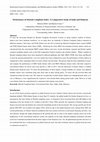
To meet the increasing demand for Shariah Compliant Investment Avenues in equity markets, number ... more To meet the increasing demand for Shariah Compliant Investment Avenues in equity markets, number of Islamic Indices have been launched worldover. As on today there are hundreds of Shariah Compliant Indices launched in different countries. Dow Jones and FTSE Global were the first to launch the Shariah Compliant Index namely DJIMI and FTSE Global Islamic Index Series (GIIS). Following the trend, MSCI also introduced Islamic Indices which are constructed from the conventional MSCI country Indices and cover seventy developed, emerged and frontier market countries including regions such as the Gulf cooperation Council countries and Arabian markets. While a number of Shariah compliant Indices have been launched by different publishers like S&P, MSCI, FTSE, Dow Jones and Russell to meet the growing demand but a very few studies have been conducted to assess the performance of these indices in comparison to their counterpart indices in terms of their risk and return. The present study has b...
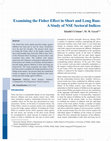
Islam, K. U., & Goyal, M. M. (2017). Examining the Fisher Effect in Short and Long Run: A Study of NSE Sectoral Indices. International Journal of Financial Management, 7(2)., 2017
The belief that stock market provides hedge against inflation has been put to test by many resear... more The belief that stock market provides hedge against inflation has been put to test by many researchers over the past few decades. The present study aims at testing the Fisher effect in the Indian context.We have used monthly data, from July 2006 to June 2016, of the National Stock Exchange sectoral indices and consumer price index. The ordinary least square regression and Johansen cointegration approach have been used to test whether or not Indian sectoral indices provide hedge against inflation in short and long run respectively. The weak exogenity test under VECM has been used to establish the hedge hypothesis in the Indian stock market. The present study has established results in support to the hedge hypothesis that stock market provides hedge against inflation.
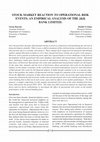
Hussain, S., & Islam, K. U. (2017). Stock Market Reaction to Operational Risk Events: An Empirical Analysis of the J&K Bank Limited. Osmania Journal of International Business Studies,(2016), 11(1&2)., 2016
Over the past three decades, Operational risk has evolved as a disastrous risk threatening the su... more Over the past three decades, Operational risk has evolved as a disastrous risk threatening the survival of financial industry globally. There is now a shift in treatment of this risk from being considered merely an idiosyncratic type to a systemic risk category. These changes have triggered a movement for determining explicit capital allocation in banks to cover their unexpected losses arising out of such a risk category. However, such a pursuit of achieving more safety has exposed banks to severe challenges in the form of development of both operational risk events database and robust risk measurement systems. Aftermath these challenges, banks have heavily invested in information technology so that adequate proprietary data bases of historical Operational risk events and sophisticated measurement models are developed. At the same time, maturity and the level of disclosures about operational risk events by the financial industry in the mature economies of the world have increased tremendously, however, such disclosures of Operational risk events by the financial industry in India though continues to be at a nascent stage. Due to this problem, the subject of Operational risk has caught less attention of the researches in India. Given the difficulties of paucity of data about operational risk events, the present study using alternate means has related print and electronic media reported operational risk events with the performance of a select banking firm to find out if such events cause adverse effects on its market performance. For this purpose, a sample comprising of wide ranging operational risk events of the select banking firm have been collected for the period 2010-2015. The study uses OLS regression analysis by employing single factor and two factor methodology to investigate the effect of operational risk events on the market performance of the selected banking firm.
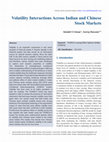
Islam, K. U., & Hussain, S. (2018). Volatility Interactions Across Indian and Chinese Stock Markets. International Journal of Banking, Risk and Insurance, 6(1), 48., 2018
Volatility is an important component in risk return analysis of financial assets. It imparts liqu... more Volatility is an important component in risk return analysis of financial assets. It imparts liquidity to the financial system and also serves as an information source for rational decision making. Since the latter half of the 20th century, volatility in stock returns has been found to be time varying and exhibiting patterns and therefore, various models have been developed to capture such dynamic properties of volatility. The introduction of Autoregressive Conditional Heteroscedasticity (ARCH) models by Engle in 1982 has led to a better understanding of the behaviour of stock market volatility than the traditional measures including standard deviation. The present study attempts to model various aspects including clustering, leverage effect and spillover effect of stock market volatility in Indian and Chinese stock markets during 2001-2016 using daily time-series data with Generalised Autoregressive Conditional Heteroscedasticity (GARCH) models. Volatility has been seen to be highly persistent in both the markets. The T-GARCH model has been applied in order to assess the presence of information asymmetry that bad news impacts volatility more than good news. Our results reveal that both Indian and Chinese stock markets' volatility shows time varying behaviour. The theoretical reasoning of the asymmetric impact of news that bad news affects volatility more than good news has been confirmed in both markets. Furthermore, the spillover effect of volatility across the two markets has been tested using the T-GARCH-X model. The results show unidirectional spillover effect of volatility from Chinese stock market to the Indian stock market. This implies that shocks from Chinese stock market impact conditional volatility in the Indian stock markets only but not vice-versa.
Hussain, S., & Ul Islam, K. (2017). Is the Capital Asset Pricing Model valid in the Indian context?. Pacific Business Review International, 9(7), 115-124., 2017
CAPM has been a great milestone in asset pricing theory, explaining the risk-return characteristi... more CAPM has been a great milestone in asset pricing theory, explaining the risk-return characteristic of financial assets. However, over a few decades the validity of CAPM has been put to test by a large number of researchers. In this study, we test the validity of CAPM in India on the stocks listed on the National Stock Exchange by using Fama and McBeth (1973) two step procedure. Our results show absence of any significant relationship between betas and risk premiums and therefore we conclude that CAPM is not a valid test in explaining the risk-return characteristics of assets listed on the National Stock Exchange over the sample period.
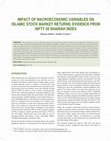
Habib, M., & Islam, K. U. (2017). Impact of macroeconomic variables on islamic stock market returns: Evidence from NIFTY 50 Shariah Index. Journal of Commerce and Accounting Research, 6(1), 37., 2017
The present paper tries to establish the impact of various macroeconomic variables on the perform... more The present paper tries to establish the impact of various macroeconomic variables on the performance of the Islamic stock market for India. Compatible with the Efficient Market Hypothesis (EMH), a number of macroeconomic variables have been documented to impact the performance of the stock market. The Arbitrage Pricing Theory (APT) laid the theoretical basis for the relationship between stock returns and macroeconomic variables which has been later on empirically tested by a large number of studies. We have used the Ordinary Least Square (OLS) Regression to study the impact of macroeconomic variables including inflation, industrial production, exchange rate, interest rates and money supply on the Islamic stock returns. The various diagnostic tests including the Breusch-Godfray Serial Correlation Lagrange Multiplier (LM) test, the Breusch-Pagan-Godfray test and the Jarque-Berra test have been used to check whether the residuals of OLS are pure white noise. The findings of our study suggest that exchange rate and interest rates have a significant impact on the Islamic stock market. The implications of the study are that exchange rates and interest rates should be controlled so as to improve the performance of the Islamic stock market in India.
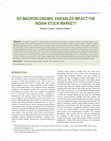
Islam, K. U., & Habib, M. (2016). Do macroeconomic variables impact the Indian stock market. Journal of Commerce & Accounting Research, 5(3), 10-17., 2016
This paper is intended to study the impact of various macroeconomic variables on Indian stock mar... more This paper is intended to study the impact of various macroeconomic variables on Indian stock market. Based on the Arbitrage Pricing Theory (APT) propounded by Ross in 1976 and various other studies, a number of macroeconomic variables including, inflation, industrial production, exchange rate, money supply, interest rate, and oil price have been identified to have a significant impact on the stock market. We have applied the multivariate extension of the classical linear regression model computed on Ordinary Least Squares method and Granger Causality test to re-establish the relationship between macroeconomic variables and stock returns over a period of 10 years from 2005 to 2015 using monthly observations. The results of this study show that only exchange rate has a significant negative impact on stock returns. The other macroeconomic variables are not significantly affecting stock returns; however, their impact is in accordance with the economic theory. The Granger Causality test reveals absence of any causal relationship between stock returns and macroeconomic variables, except in case of oil prices, where we find a unidirectional causal relationship running from stock returns to oil prices. However, the Granger Causality results should not be taken in the conventional meaning of causality, but results merely identifying precedence
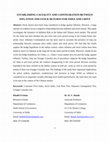
Islam, K. U., & Jhamb, H. (2016). Establishing causality and cointegration between inflation and stock returns for India and China. ., 2016
Stock returns have been long considered as hedge against inflation. However, a large amount of ev... more Stock returns have been long considered as hedge against inflation. However, a large amount of evidence favors a negative relationship between inflation and stock returns. This paper investigates the dynamics of Inflation Risk in the Indian and Chinese stock market. The period for the study has been divided into pre-crisis and crisis period owing to the United States sub-prime crisis. Johansen Cointegration test has been used to ascertain the presence of long run relationship between consumer price index values and stock prices. We find that the results support the hedge hypothesis in the Indian context, where inflation and stock returns have been found to move in cohesion in the long run for the entire period of study. However, results do not verify the hedge hypothesis for China, i.e., China's stock market does not provide hedge against inflation. Further, long run Granger Causality test of precedence supports the hedge hypothesis for India in pre-crisis period, the evidence disappearing in the crisis period. Reverse causality hypothesis has been verified in the Indian context in both pre-crisis as well as crisis period by
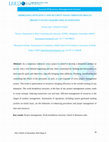
As a temporary endeavor, every project is aimed to develop a distinctive product or service with ... more As a temporary endeavor, every project is aimed to develop a distinctive product or service with a well defined beginning and end, often constrained by funding and deliverables, to meet specific goals and objectives, typically bringing value additions. Planning, coordinating and controlling the efforts of the personnel, as such, is a prerequisite of every project management system. This leads to optimization of resources, bringing efficiency in the overall working of any enterprise. The work breakdown structure, at the base of any project management system, tends to create synergy, reducing transaction cost and time. Efficient management of resources is the slogan of modern management. Automation of operations, including system generated mailing systems on timely basis, are the hallmarks of enhancing procedures and proper management of time and resources. The objective of this paper is to provide an insight about the effective management of resources and time at FCI, through a well planned and executed project management system. The paper has been organized as per the following structure below:
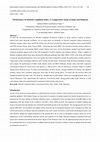
Habib, M., & Islam, K. U. (2014). Performance of Shariah compliant index: A comparative study of India and Malaysia., 2014
To meet the increasing demand for Shariah Compliant Investment Avenues in equity markets, number ... more To meet the increasing demand for Shariah Compliant Investment Avenues in equity markets, number of Islamic Indices have been launched worldover. As on today there are hundreds of Shariah Compliant Indices launched in different countries. Dow Jones and FTSE Global were the first to launch the Shariah Compliant Index namely DJIMI and FTSE Global Islamic Index Series (GIIS). Following the trend, MSCI also introduced Islamic Indices which are constructed from the conventional MSCI country Indices and cover seventy developed, emerged and frontier market countries including regions such as the Gulf cooperation Council countries and Arabian markets. While a number of Shariah compliant Indices have been launched by different publishers like S&P, MSCI, FTSE, Dow Jones and Russell to meet the growing demand but a very few studies have been conducted to assess the performance of these indices in comparison to their counterpart indices in terms of their risk and return. The present study has been undertaken to assess and compare the performance of MSCI India Islamic index and MSCI Malaysia islamic index with their respective conventional Indices for eleven years time period i.e, 2003 to 2013. Also the behaviour of Islamic Indices is studied











Uploads
Papers by khalid Ul Islam